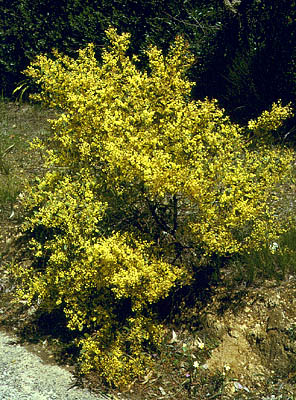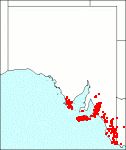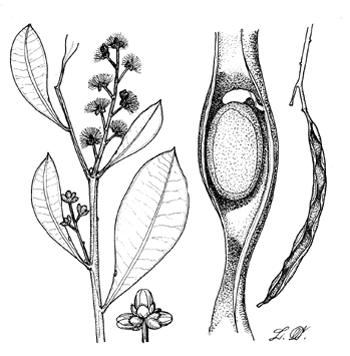Family: Fabaceae
Acacia myrtifolia

Citation:
C. L. Willdenow, Sp. Pl. 4:1054 (1806); Mimosa myrtifolia Sm., Trans. Linn. Soc. Lond. 1:252 (1791).
Derivation: myrtifolia--phyllodes resemble the leaves of the common European myrtle. Synonymy: Racosperma myrtifolium (Smith)Martius, Hort. Reg. Monac. Semin. (1835). , Acacia myrtifolia, Mimosa myrtifolia Common name: Myrtle wattle
Description:
Erect, glabrous, bushy shrubs 1-2 m high; branchlets acutely angular, reddish. Phyllodes variable in shape, linear-lanceolate, oblanceolate, obliquely ovate or more or less elliptical, 2-10 cm long, 4-30 mm broad, flat, coriaceous, glabrous, 1 prominent vein and thickened pale yellowish vein-like margins, apex acute often mucronate; glands conspicuous reddish-brown on upper margin below the middle of the phyllodes, young phyllodes often with a conspicuous reddish tinge. Inflorescences in axillary glabrous racemes about as long as, or occasionally, longer than phyllodes; flower-heads more or less globular, pale yellow, 2-4-flowered, and at first covered with broad brown bracts; peduncles glabrous, 4-8 mm long; flowers 4-merous. Legumes linear, 4-7 cm long, c. 4 mm broad, thick, woody, curved; margins thickened, light brown, not constricted. Seeds longitudinal in legume; funicle short, arillate.
|
|
Distribution:
|
From the Eyre Peninsula region (southern part), abundant in the Northern and Southern Lofty regions, rare on Yorke Peninsula and scattered on Kangaroo Island, then through the South-Eastern region from near Cooke Plains, then south-east to the Victorian border. In a variety of vegetation communities from open forest, woodland, to open scrub. A small pocket of plants have recently been found growing in open scrub area north of Foul Bay on Yorke Peninsula. Soils: on a variety of soils from hard acid yellow duplex to sandy alkaline yellow duplex. Rainfall 500-1200 mm. Also W.Aust., Qld, N.S.W., Vic. and Tas.
S.Aust.: EP, NL, MU, YP, SL, KI, SE.
|
Conservation status:
Lang & Kraehenbuehl (1987) consider this species to be of no special conservation significance. Flowering time: July — October. |

SA Distribution Map based
on current data relating to
specimens held in the
State Herbarium of South Australia
|
Biology:
No text
Taxonomic notes:
Leaf gain and loss of A. myrtifolia were studied by Maconochie (1975). The plants studied were in the vicinity of the Para Wirra Reserve, Mt Lofty Ranges and remarkably produced no new growth in the first 12 months of study although they did flower. Thereafter shoot growth reached a peak in October following flowering. The peak of leaf loss more or less coincided with the peak of production.For the results of seed chipping and hot water treatments on seed germination see Clemens et al. (1977). The four taxa of native bees foraging on A. myrtifolia flowering in Victoria were studied by Bernhardt & Walker (1984). Most carried Acacia pollen and virtually all also carried pollen from other genera. Bees took secretions from the floral nectaries as well as collecting pollen. Var. angustifolia Benth., Fl. Aust. 2:377 (1864) This name has been applied to variants with distinctively long narrow phyllodes found on Kangaroo Island, see Fig. B. Well developed plants are readily recognised, but as some intermediates occur, more work needs to be done on the status of this variety which is largely confined to the lateritic uplands of the island.
Cultivation:
An attractive shrub suitable for ornamental or rockery planting. Very fast growth rate.
Author:
Not yet available
Source:

|

